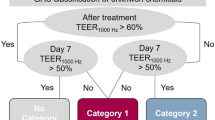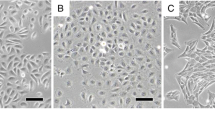Abstract
Evaluation of the eye irritation is essential in the development of new cosmetic products. Draize rabbit eye irritation test has been widely used in which chemicals are directly applied to rabbit eye, and the symptoms and signs of eyes are scored. However, due to the invasive procedure, it causes substantial pain and discomfort to animals. Recently, we reported in vitro eye irritation test method using a 3D human corneal epithelial model (MCTT HCE™) which is reconstructed from remaining human tissues after a corneal transplantation. This model exhibited an excellent predictive capacity for 25 reference chemicals (sensitivity 100 %, specificity 77 % and accuracy 88 % vs. GHS). To improve the test performance, we explored new biomarkers for the eye irritation through transcriptomic approach. Three surfactants were selected as model eye irritants that include sodium lauryl sulfate, benzalkonium chloride and triton X-100. After test chemicals were treated, we investigated differentially expressed genes through a whole-gene microarray (Affymetrix GeneChip® Human Gene 2.0 ST Array, 48,000 probes). As a result, we identified that mRNAs of cornifelin (CNFN), a constituent of the insoluble cornified cell envelope of stratified squamous epithelia, and early growth response-1 (EGR1), a nuclear transcriptional regulator, were significantly up-regulated by all three irritants. Up-regulation of CNFN and EGR1 was further confirmed by Q-RT-PCR, and immunohistochemistry revealed increased level of CNFN in irritant-treated tissues, supporting the relevance of CNFN and EGR1 as new biomarkers for eye irritation.





Similar content being viewed by others
References
Adriaens E, Barroso J, Eskes C et al (2014) Retrospective analysis of the Draize test for serious eye damage/eye irritation: importance of understanding the in vivo endpoints under UN GHS/EU CLP for the development and evaluation of in vitro test methods. Arch Toxicol 88(3):701–723. doi:10.1007/s00204-013-1156-8
Alepee N, Bessou-Touya S, Cotovio J et al (2013) Cosmetics Europe multi-laboratory pre-validation of the SkinEthic reconstituted human corneal epithelium test method for the prediction of eye irritation. Toxicol in vitro 27(5):1476–1488. doi:10.1016/j.tiv.2013.02.009
Borlon C, Godard P, Eskes C, Hartung T, Zuang V, Toussaint O (2007) The usefulness of toxicogenomics for predicting acute skin irritation on in vitro reconstructed human epidermis. Toxicology 241(3):157–166. doi:10.1016/j.tox.2007.08.096
Cotovio J, Grandidier M-H, Lelièvre D et al (2007) The use of the reconstructed human corneal model (HCE) to assess in vitro eye irritancy of chemicals. ALTeX 14:343–350
Cotovio J, Grandidier MH, Lelievre D et al (2010) In vitro assessment of eye irritancy using the reconstructed human corneal Epithelial SkinEthic HCE model: application to 435 substances from consumer products industry. Toxicol in vitro 24(2):523–537. doi:10.1016/j.tiv.2009.11.010
de Vries RB, Leenaars M, Tra J et al (2013) The potential of tissue engineering for developing alternatives to animal experiments: a systematic review. J Tissue Eng Regen Med. doi:10.1002/term.1703
Doucet O, Lanvin M, Thillou C et al (2006) Reconstituted human corneal epithelium: a new alternative to the Draize eye test for the assessment of the eye irritation potential of chemicals and cosmetic products. Toxicol in vitro 20(4):499–512. doi:10.1016/j.tiv.2005.09.005
Draghici S, Khatri P, Eklund AC, Szallasi Z (2006) Reliability and reproducibility issues in DNA microarray measurements. Trends in genetics : TIG 22(2):101–109. doi:10.1016/j.tig.2005.12.005
Eckert RL, Sturniolo MT, Broome AM, Ruse M, Rorke EA (2005) Transglutaminase function in epidermis. J Invest Dermatol 124(3):481–492. doi:10.1111/j.0022-202X.2005.23627.x
Gloxhuber C (1974) Toxicological properties of surfactants. Arch Toxicol 32(4):245–270
Jung KM, Lee SH, Ryu YH et al (2011) A new 3D reconstituted human corneal epithelium model as an alternative method for the eye irritation test. Toxicol in vitro 25(1):403–410. doi:10.1016/j.tiv.2010.10.019
Kaluzhny Y, Kandarova H, Hayden P, Kubilus J, d’Argembeau-Thornton L, Klausner M (2011) Development of the EpiOcular™ eye irritation test for hazard identification and labelling of eye irritating chemicals in response to the requirements of the EU cosmetics directive and REACH legislation. ATLA 39(4):339–364
Katoh M, Hamajima F, Ogasawara T, Hata K (2013) Establishment of a new in vitro test method for evaluation of eye irritancy using a reconstructed human corneal epithelial model, LabCyte CORNEA-MODEL. Toxicol in vitro 27(8):2184–2192. doi:10.1016/j.tiv.2013.08.008
Liang H, Pauly A, Riancho L, Baudouin C, Brignole-Baudouin F (2011) Toxicological evaluation of preservative-containing and preservative-free topical prostaglandin analogues on a three-dimensional-reconstituted corneal epithelium system. Br J Ophthalmol 95(6):869–875. doi:10.1136/bjo.2010.189449
Meloni M, Pauly A, Servi BD, Varlet BL, Baudouin C (2010) Occludin gene expression as an early in vitro sign for mild eye irritation assessment. Toxicol in vitro 24(1):276–285. doi:10.1016/j.tiv.2009.08.016
Michibata H, Chiba H, Wakimoto K et al (2004) Identification and characterization of a novel component of the cornified envelope, cornifelin. Biochem Biophys Res Commun 318(4):803–813. doi:10.1016/j.bbrc.2004.04.109
Pauly A, Meloni M, Brignole-Baudouin F, Warnet JM, Baudouin C (2009) Multiple endpoint analysis of the 3D-reconstituted corneal epithelium after treatment with benzalkonium chloride: early detection of toxic damage. Invest Ophthalmol Vis Sci 50(4):1644–1652. doi:10.1167/iovs.08-2992
Saeed AI, Sharov V, White J et al (2003) TM4: a free, open-source system for microarray data management and analysis. Biotechniques 34(2):374–378
Steiling W, Bracher M, Courtellemont P, de Silva O (1999) The HET–CAM, a useful in vitro assay for assessing the eye irritation properties of cosmetic formulations and ingredients. Toxicol in vitro 13(2):375–384
Stern M, Klausner M, Alvarado R, Renskers K, Dickens M (1998) Evaluation of the EpiOcular™ tissue model as an alternative to the Draize eye irritation test. Toxicol in vitro 12(4):455–461
Sukhatme VP, Kartha S, Toback FG, Taub R, Hoover RG, Tsai-Morris CH (1987) A novel early growth response gene rapidly induced by fibroblast, epithelial cell and lymphocyte mitogens. Oncog Res 1(4):343–355
Van Goethem F, Adriaens E, Alepee N et al (2006) Prevalidation of a new in vitro reconstituted human cornea model to assess the eye irritating potential of chemicals. Toxicol in vitro 20(1):1–17. doi:10.1016/j.tiv.2005.05.002
Zhang F, Lin M, Abidi P, Thiel G, Liu J (2003) Specific interaction of Egr1 and c/EBPbeta leads to the transcriptional activation of the human low density lipoprotein receptor gene. J Biol Chem 278(45):44246–44254. doi:10.1074/jbc.M305564200
Zhang L, Cho J, Ptak D, Leung YF (2013) The role of egr1 in early zebrafish retinogenesis. PLoS ONE 8(2):e56108. doi:10.1371/journal.pone.0056108
Acknowledgments
This work is supported by Ministry of Food and Drug Safety of Korea, Grant No. 13172MFDS987 and the National Research Foundation (NRF) Grant of the Korea government (MEST), No. NRF-2013R1A1A1007072.
Author information
Authors and Affiliations
Corresponding authors
Rights and permissions
About this article
Cite this article
Choi, S., Lee, M., Lee, SH. et al. Identification of cornifelin and early growth response-1 gene as novel biomarkers for in vitro eye irritation using a 3D reconstructed human cornea model MCTT HCE™. Arch Toxicol 89, 1589–1598 (2015). https://doi.org/10.1007/s00204-014-1390-8
Received:
Accepted:
Published:
Issue Date:
DOI: https://doi.org/10.1007/s00204-014-1390-8




